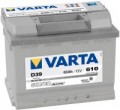Maintenance
—
Serviceable. Only classic lead-acid batteries (see "Type") are serviceable: they can be easily identified even externally by the presence of removable caps that provide access to the internal compartments with electrolyte. The latter is a mixture of sulfuric acid and water, and with each charge, some of this water "boils off" (breaks down into oxygen and hydrogen and evaporates). This occurs especially intensively during overcharging or charging at increased voltage. Battery maintenance consists of periodically replenishing the water supply in the electrolyte—without this, the decrease in its level leads to plate damage due to contact with air, which irreparably worsens the battery's characteristics. On average, maintenance needs to be carried out 1-2 times a year (15-20 thousand km mileage for a passenger car), and these periods usually coincide with scheduled maintenance. However, this value may vary depending on the characteristics of both the battery itself and its operation; more detailed information is usually contained in the instructions for specific models. "Refilling" should be done exclusively with distilled water, as even relatively small amounts of foreign impurities can damage the plates.
—
Maintenance-free. As the name suggests, such batteries do not require the maintenance described above; this is achieved by several methods, in particular by filling the electrolyte with a reserve f
...or the entire service life or using gel (see "Type"). Despite the obvious advantages due to ease of use, maintenance-free batteries have one drawback: they are much more sensitive to deep discharge (capacity decreases), and, accordingly, they are less tolerant of cold and long downtimes.Battery capacity
The electrical capacity of a battery, in other words, the amount of energy stored by a battery when fully charged. The capacity value is expressed in amp-hours and indicates the number of hours during which a fully charged battery will be discharged to the minimum allowable charge, delivering a current of 1 ampere to the load. For example, a capacity of 40 Ah means that the battery is capable of delivering a current of 1 A for 40 hours, or 2 A for 20 hours, etc. In fact, a more capacious battery gives more attempts to start the engine, and is also able to work longer at a low load (for example, when powering a car audio system).
The capacity requirements for different transport types differ markedly. So, in motorcycle batteries, it rarely exceeds 20 Ah, the average value for passenger cars is 40-80 Ah (but there are options for 100 Ah or more), and for heavy equipment like buses, an acceptable capacity starts somewhere from 100 Ah. The optimal value of the battery capacity is often indicated by the manufacturer in the characteristics of the vehicle, and when choosing a model by capacity, you should focus primarily on these figures.
Charge indicator
Has
a charge indicator on the battery.
Such an indicator displays the current charge level and allows you to generally assess the state of the battery literally at a glance, without additional actions and diagnostic equipment. In some models of serviceable batteries, the indicator can signal not only the need for charging, but also the need to add water to the electrolyte (for more details, see "Maintenance").

